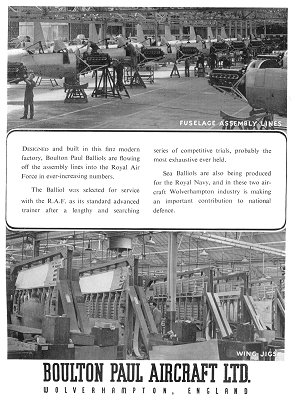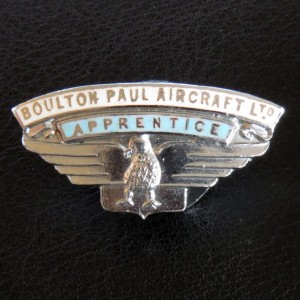Dowty Boulton Paul - Works History

Boulton Paul - Fuselage Assembly Line

Boulton Paul - Wing Jigs

Boulton Paul - Fuselage Assembly Line

Boulton Paul - Works Employees

Boulton Paul Works

Boulton Paul - Sports and Welfare Society membership badge (SWS)

BPA Enamel Pin Badge with Number (2)
Les Whitehouse

Boulton Paul - Apprentice Badge

BPA Permit To Enter Works
Les Whitehouse
Boulton Paul Aircraft Ltd was a British aircraft manufacturer that was incorporated in 1934, although its origins in aircraft manufacturing began earlier in 1914, and lasted until 1961.
The company mainly built and modified aircraft under contract to other manufacturers, but had a few notable designs of its own, such as the Defiant fighter and the Balliol trainer.
The company’s origins date back to an ironmonger’s shop founded in 1797 in Norwich. By the early 1900s, Boulton & Paul Ltd was a successful general manufacturing firm.
The aircraft building business was sold off from the main construction business in 1934 and then moved to Wolverhampton under its new name Boulton Paul Aircraft Ltd.
In 1961 Boulton Paul joined the Dowty Group to become solely an aircraft component manufacturer.
Today it is a part of the even larger TI group.





Comments about this page
The company were not known to be producing ‘new’ marine engines during that time but would have very likely been involved in the maintenance of existing products – which would have been a huge number given the sales at home and abroad. It’s likely that skilled engineers and other tradesmen could have been required and therefore it is possible – although there’s no specific reference to such a thing occurring. “Boulton & Paul Marine Engines ceased production in 1917 other than parts for spares and overhaul and the test beds moved into the general engineering section to cover repairs of these.
I believe that it is a fair assumption that Boulton & Paul Norwich were probably not producing their own design static engines during WW2, because officially they decided to abandon the engines in 1934 (Last engine driven ‘electrolyte’ generating unit was boxed up in 1932) and transfer of the designs to Boulton Paul Aircraft Ltd were not allowed under the “produce aircraft only for 10 years” sales agreement (even if J D North had wanted them).
However, many hundreds of marine engines, marine lighting generator sets and bilge pump sets along with stationary engines and civil generator sets had been produced from 1906 to 1934, even for the Army, Admiralty and RAF at home and abroad, so these units had to be supported by spares, maintenance, troubleshooting advice, plus potential rebuild and repairs to return them to service. The company would be pressured by wartime service requirements to do all they could at the time, so the maintenance stands – still existing and transferred for the support of the in-company operating plant – could well have been fully utilised in this respect and require an increase in good engineers and tradesmen to cope with demand.
There is nothing known to prove that they ever put batches of complete engines back into production but the provision of spares could have made it seem that way because hundreds were small auxiliary engines on vessels and boats . Some of the tooling and jigs may have been transferred to Australia for Electrolite Products, Australia Pty, (date unknown) who were manufacturing under licence from Boulton & Paul and advertising new generator units for sale as late as 1949.
Norfolk Record Office acquisition 1997/146 Box 44 covers “Electrical. Water Elevator and Marine Engine brochures”.
Although I have not been through it myself I have some photocopies probably from originals finally deposited in that record.
Kind Regards
Les Whitehouse
Archivist – Boulton Paul Association”
This is more of a question… did they do war work on marine engines… only I understand my father was sent to Norwich during the war as an engineer and that he worked on marine engines… sadly no longer here to ask can you help
Hello Les… many thanks for the correction, we will edit the caption accordingly….
Your war service badge is actually only the Sports and Welfare Society membership badge (SWS) from the 1950’s. The war service badges were larger and had the clock number engraved upon them to prevent misuse.
The original company (Moore’s) as a shop did not exist until 1803. The 1916 B&P publication only said it was founded ‘about’ 1797. In fact that was the date Moore left Norfolk to learn the ironmongery trade in Birmingham, not returning until 1803.
Add a comment about this page